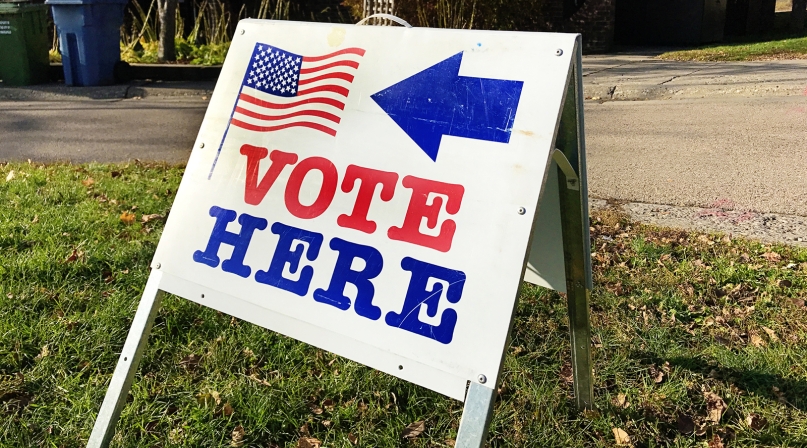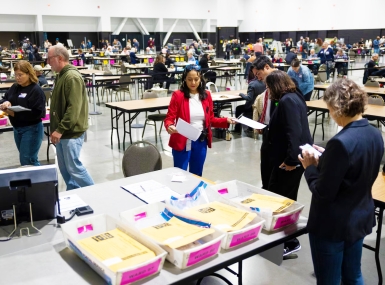Supreme Court upholds Ohio’s purge of voter rolls

Key Takeaways
In Husted v. A. Philip Randolph Institute the Supreme Court held that Ohio’s processes of removing people from the voter rolls does not violate federal law. If a person doesn’t vote for two years, Ohio sends them a confirmation notice. If they don’t respond to the notice and don’t vote in the next four years, Ohio removes them from the voter rolls.
The State and Local Legal Center (SLLC) filed an amicus brief in this case supporting Ohio. Twelve other states maintain their voter rolls using a similar process.
The National Voter Registration Act (NVRA) allows states to remove voters if they don’t respond to a confirmation notice and don’t vote in the next two federal election cycles. But the “Failure-to-Vote Clause” says a state program “shall not result in the removal of the name of any person . . . by reason of the person’s failure to vote.”
Two advocacy groups and an Ohio resident claimed Ohio’s process violates the NVRA’s Failure-to-Vote Clause because “the failure to vote plays a prominent part in the Ohio removal scheme.” They argue failure-to-vote is used as a trigger for sending the confirmation notice and as a requirement for removal.
The Supreme Court, in a 5–4 opinion written by Justice Samuel Alito, concluded the Ohio process doesn’t violate the NVRA. First, it is undisputed the Ohio process follows the NVRA “to the letter.” Second, Justice Alito pointed to other language in the NVRA stating that registrants may not be removed “solely by reason of a failure to vote.” According to the court, the NVRA “simply forbids the use of nonvoting as the sole criterion for removing a registrant, and Ohio does not use it that way. Instead, as permitted by [the NVRA], Ohio removes registrants only if they have failed to vote and have failed to respond to a notice.”
The challengers also argued that because so many people discard the confirmation notice, the failure to send it back is “worthless” as evidence someone has moved and is ineligible to vote. The Supreme Court rejected the notion it should second-guess the Ohio Legislature’s “considered judgment” regarding the “probative value” of a registrant’s failure to respond to the confirmation notice.
The court again relied on respecting the judgment of the Ohio Legislature in rejecting the challengers’ argument that “Ohio’s procedure is illegal because the State sends out notices without having any ‘reliable indicator’ that the addressee has moved.” According to the court, “the Ohio Legislature apparently thought that nonvoting for two years was sufficiently correlated with a change of residence to justify sending a [confirmation notice].”
The SLLC amicus brief points out that hundreds, if not thousands, of states and local governments are tasked with registering voters and maintaining voter rolls. Processes vary based on factors including state law and resources; so, states and local governments need clear direction and flexibility regarding what process they may use to maintain voter rolls. The brief notes that while in this case Ohio is being sued for the process it uses to take people off the rolls, states and local governments have been sued for keeping ineligible voters on the rolls.
David Orr, Cook County clerk and election administrator, labeled the court’s decision “partisan” in a statement released shortly after the decision. “In a partisan 5-4 vote, the Court upheld the state of Ohio’s uniquely aggressive efforts to purge its voting rolls, ruling that a state may kick people off the rolls if they skip a few elections and fail to respond to a notice from state election officials … The burden should be on the election administer to keep current voter rolls and not outsource their duty onto the back of voters,” Orr said.
Retaliatory arrest case
It is tempting to dismiss this case as a mere one-off. But every local government has a Fane Lozman (or two, three, or four) and this case provides a cautionary tale.
In an 8–1 decision in Lozman v. Riviera Beach, the Supreme Court held that a citizen who was arrested for making comments at a city council meeting (possibly because the city had an official policy of retaliating against him) was not barred from bringing a First Amendment retaliatory arrest claim against the city even if it had probable cause to arrest him.
Lozman was an “outspoken critic” of the City of Riviera Beach’s proposed plan to redevelop the city-owned marina using eminent domain. He also sued the city claiming it violated open meetings law. He alleged that the City Council held a closed-door meeting in which it devised an official plan to intimidate him in retaliation for his lawsuit.
Five months after the closed-door meeting, a councilmember had Lozman arrested during the public comment period for discussing issues unrelated to the city and refusing to leave the podium. Lozman conceded that the city had probable cause to arrest him. But he claimed the city should be liable for violating the First Amendment because its strategy to intimidate him to stop speaking was a “but for” cause of his arrest.
In contrast, the city argued that Lozman could not sue it for retaliatory arrest under any circumstances if probable cause existed to arrest him. In an opinion written by Justice Anthony Kennedy, the court declined to decide whether to extend either the “but for” cause rule proposed by Lozman or the absolute bar to retaliatory arrest claims proposed by the City to the “mine run” of First Amendment retaliatory arrest claims. Instead, the court held that because of the unique facts of this case Lozman “need not prove the absence of probable cause to maintain a claim of retaliatory arrest against the City.”
The State and Local Legal Center (SLLC) filed an amicus brief arguing that an arrestee could not bring a First Amendment retaliatory arrest lawsuit if probable cause for the arrest existed.
The SLLC amicus brief argued that if probable cause is present and officers can still be sued, states and local governments will have more difficulty maintaining order and safety at local-government meetings, public protests and demonstrations and political rallies. Additionally, the brief pointed to the role of state constitutions, state courts and internal disciplinary measures within state and local police departments to protect free speech and offer “meaningful remedies for true victims of retaliation.”
The court declined to decide whether, as a general rule, probable cause bars First Amendment retaliation cases against police officers.
Soronen is executive director of the State and Local Legal Center. NACo is a founder, a funder and a board member of the SLLC, headquartered in Washington, D.C. The center extends NACo’s advocacy on behalf of counties to the highest court in the land.
Attachments
Related News

Multi-State Information Sharing and Analysis Center (MS-ISAC) loses federal funding
On March 11, the Cybersecurity and Infrastructure Security Agency (CISA) announced a $10 million cut in funding for the Multi-State Information Sharing and Analysis Center (MS-ISAC), which provides critical local assistance for cybersecurity threat detection and analysis resources and support.
Election administrators anticipate continued challenges
The 2024 election was success in the eyes of elections administrators, but several panelists see areas of concern brewing for future years.

Counties overcome challenges on Election Day
In the aftermath of Election Day, county election offices across the country are taking note of the challenges they faced, including bomb threats, technical issues and ballot printing problems that led to extending voting hours and recounting ballots or duplicating them to be properly scanned.
